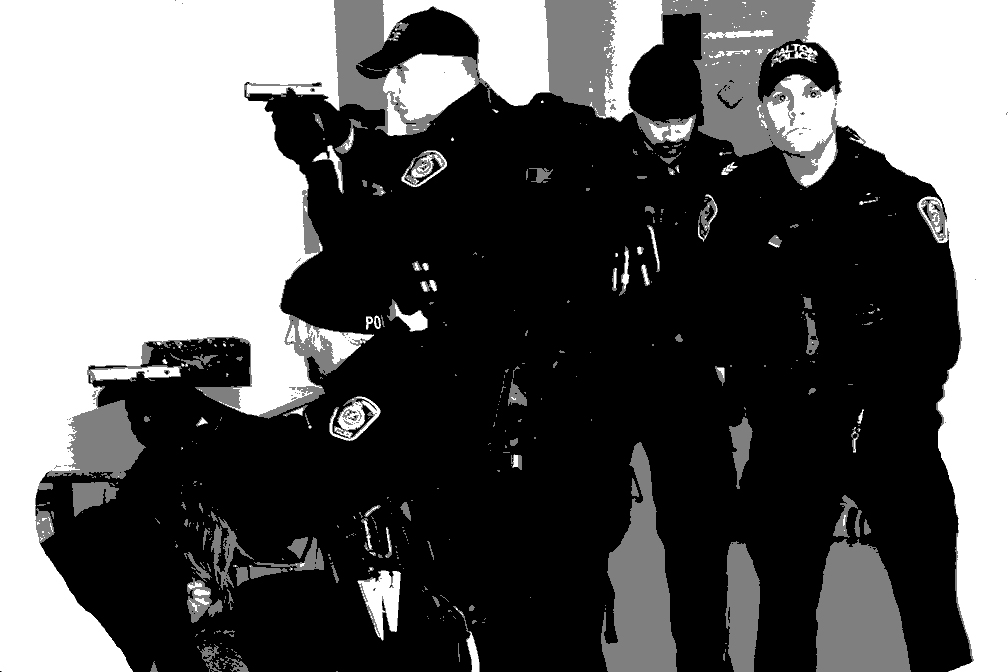EDITORIAL
On Nov. 25, Sheridan College, in concert with Halton Regional Police, held a lockdown drill and police training exercise in the SCAET building. The drill involved Sheridan theatre students playing victims in special effects makeup to simulate real gunshot wounds for a life like training exercise.
Students at the Sheridan Sun were granted access to cover the event as it unfolded and worked hard to bring that coverage to our readers. Despite not having received a single complaint, within an hour of being posted online, college officials ordered The Sun to remove much of that coverage from its website.
Sandy McKean, Associate Dean of Film, Television and Journalism at Sheridan, felt the content originally posted was of questionable news value. “I asked the content be taken down based on professional practice in journalism because there was an excessive use of violent images,” he said.
It was made clear to organizers during the planning of our coverage that Sun reporters intended to take both pictures and video during the event and was told where they could place their stationary cameras. Some reporters were provided vests by organizers that allowed them to remain out of lockdown to cover the event. The Sheridan Production House requested some of the Sun’s footage to use in their official video being made for the college.
Journalism students were even asked to take part in a mock press conference following the dramatization, but were later told they couldn’t report what was said.
The team of Sun reporters assigned to the story worked diligently to present it in a manner that reflected the uniqueness of the event and showcased the work done by students, while at the same time keeping the event in context as a mock exercise and not a real school shooting.
A video of the dramatization was compiled and a comprehensive explanation and viewer discretion warning preceded the footage before it was uploaded to thesheridansun.ca. A banner in large red letters was even placed at the top of the frame as a constant reminder to viewers that they were watching actors during a staged event.
In demanding that the video and other segments be removed, college officials attested that coverage of the actors made-up as victims was excessive and exploitive.
McKean came into the newsroom Tuesday and selected the images that were to be removed from the site. The coverage was significantly reduced and the editorial decisions that were made as a paper after careful consideration were called into question.
If the paper’s coverage of the event was too graphic, then that was a reflection of the event itself. All Sheridan Sun reporters did that day was point their cameras and shoot.
Some of the images and the video were said to go beyond what was necessary to tell the story. McKean, who in effect is the paper’s publisher, ultimately felt some of the coverage violated journalistic principles.
Coverage decisions were not made in a vacuum. The Sun’s team of reporters and photographers pulled together as a unit.
They earned kudos from their instructors, whose combined industry experience exceeds 150 years.
Some of the more graphic pictures of the mock lockdown were chosen because they showcased not only the photojournalism skills of Sun staff, but also the talents of student actors and makeup artists. The event was unprecedented in providing police and security training for the college.
Given the paper’s target audience, the coverage was significant, interesting and new – the three main criteria for news.
What are college officials afraid will offend? The fact an exercise as graphic as this being held during class time? Or the paper’s coverage of it? Is it the students’ and paper’s image that’s being protected, or the college’s?
“The directives about what should have and shouldn’t have been covered should have come from [Sandy McKean] as head of the department,” said Sheridan spokesperson Christine Szustaczek. “From what I understand, he felt that it violated a code of ethics and journalistic principles.”
Szustaczek says no complaints about the lockdown exercise were ever received.
Censorship is unacceptable in any institution of higher learning, but it’s especially destructive in an environment where artistic freedom is a necessary component of the curriculum.
If the standard for censorship at this institution is the mere possibility of offending someone at the college’s expense, does that not call into question the appropriateness of the multiple versions life-drawing nudes often posted in the hallways? Or, how about racy photography produced by students and displayed around campus?
It’s a dangerous and slippery slope.

Comments
2 responses to “College’s image vs. student freedoms”
Great job publishing this article in protest of censorship. We will not stand for censorship in any school publications. The school administrators have no right to censor what was certainly a great show of journalistic photography and of acting by school members. Keep fighting them, and I hope to see your original article back up here!
Tim Whaling
Photo Editor
The Featherduster
Austin TX
Looks like the big “S” that was erected outside the SCAET building stands for “Shut up.”